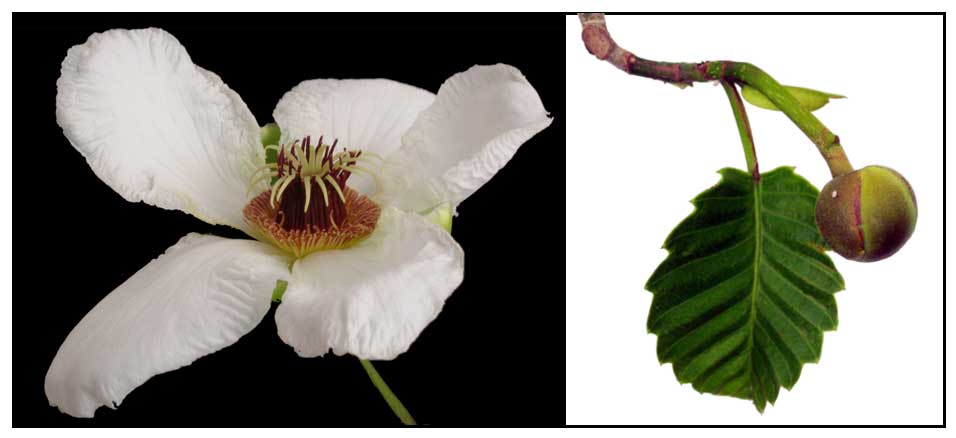 Gen info Gen info
- Dillenia is a genus of about 100 species of evergreen and deciduous trees and shrubs.
-
Dillenia philippinensis (katmon) is a species of flowering plant in the family Dilleniaceae. It is endemic to the Philippines.
- Etymology: The genus name Dillenia honors Johannes Jacobus Dillenius (1684-1747), a British botanist and physician, and the first President of the Botanical Society of London. The specific epithet philippinensis refers to the Philippines. (25)
- Katmon is featured on the reverse side of the Philippine 25-centavo coin of 2018 as part of the New Generation Currency Coin Series.
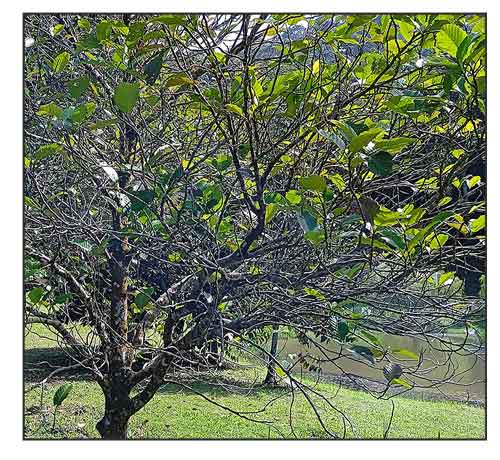 Botany Botany
• Katmon is a tree reaching a height of 6 to 15 meters, smooth or nearly so. Leaves are leathery, shining, ovate, elliptic or oblong-ovate, 12 to 25 centimeters long, and coarsely toothed at the margins. Flowers are white, large, soft, fleshy, and green, 6 to 8 centimeters in diameter, with large fleshy sepals tightly enclosing the true fruit.
• Katmon is a medium-sized evergreen tree that grows as high as 10 to 15 meters. Its trunk is erect and the branches usually start midway of the trunk. The tree is buttress-forming, evergreen, and shade tolerant. The bark is smooth with shallow fissures. The leaves are leathery, shining, ovate, elliptic or oblong-ovate, about 12 to 25 centimeters long, and coarsely toothed at the margins. Its flowers are white, large, showy, and about 15 centimeters in diameter with reddish pistils and stamens. The edible fruits are rounded, about six to eight centimeters in diameter, with large fleshy sepals tightly enclosing the true fruit. (17)
• Growth form: Evergreen small tree, able to grow up to about 6 - 15 m tall. Trunk: Bark is shallowly fissured and grayish-brown to reddish-brown. Foliage: Green elliptic to oblong-ovate leaves, simple and alternate arrangement, margins serrate, venation prominent, measuring about 8 - 25 cm long and 6 - 16 cm wide, petiole about 3.5 - 5 cm long with broad, caducous stipules about 1 cm wide. Flowers: White 5-petaled flower about 10 - 15 cm wide, solitary or paired, 5 white petals obovate in shape and about 4 - 6 cm long, 5 pale green sepals cup-shaped, stamens in 2 groups (outer stamens yellow and about 11 mm long, inner stamens purple and about 15 - 23 mm long). Fruit: Fruit is globose in shape and about 5 - 6 cm wide, consist of black seeds embedded in a soft pulp inside. (Flora & Fauna Web)
Distribution
- Endemic to the Philippines.
- In low to medium forests throughout the Philippines, but does not survive the cold upland climates.
- Categorized as "Vulnerable" in IUCN Red of List of Threatened Species (Date assessed: 01/01/1998)
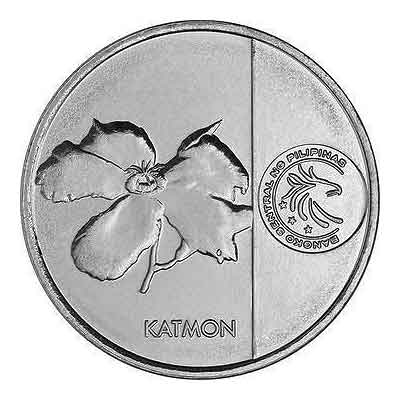 Constituents Constituents
- Study of air-dried leaves of Dillenia philippinensis yielded betulnic acid and 3-oxoolean-12-en-30-oic acid. (See study below) (1)
- Study of leaves yielded 11 compounds including one new sulfated glucoside and a new seco-A-ring oleanane-type triterpenoid. (See study below) (2)
- Air-dried leaves yielded betulinic acid.
Properties
- Leaves and bark are laxative and astringent.
- Studies suggest antimicrobial, anti-inflammatory, analgesic, antidiabetic, hypoglycemic, antioxidant, xanthine oxidase inhibitory, antihypperuricemic, food preservative properties.
Parts
utilized
- Fruit, leaves, bark.
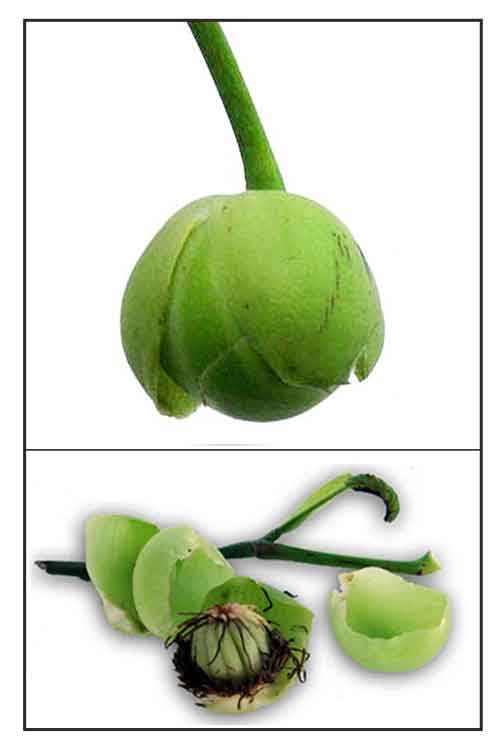 Uses Uses
Edibility
• Fruit contains a soft, fleshy, green and edible pulp, with the flavor of a green, sour apple.
• Used for making sauces and jams; also used for flavoring fish.
• Fruit when cooked, used as vegetable.
• Fruit used as base ingredient in an Instant sinigang powder mix. (see study below) (16)
Folkloric
• In the Philippines, fruit used for treatment of cough and asthma; leaves used for cough and colds; pulp of fruit used for dizziness.
•
The acid juice of the fruit, mixed with sugar, is used for coughs.
• Fruit decoction used for cough and chest pains.
• Also employed for cleansing the hair.
• In Sabah, young leaves or stem bark pounded and applied as paste on swellings and wounds.
• Elsewhere, sugared fruit juice used as cooling beverage for fevers; also, as cardiotonic.
• Leaves and bark used as laxative and astringent.
Others
• Red dye: A red dye is obtained from the tree bark.
• Wood: Has a beautiful silver grain similar to quartered oak. Provides a useful timber. Used for posts, beams joists, rafters, flooring, sheathing and ceiling, furniture and cabinetry work, musical instruments, paving blocks, and mine timber. (15)
Studies
• Antimicrobial Triterpenes / Leaves: Study of air-dried leaves of Dillenia philippinensis yielded betulnic acid and 3-oxoolean-12-en-30-oic acid. The two compounds exhibited moderate activity against fungus Candida albicans and slight antibacterial activity against E. coli, P. aeruginosa, S. aureus, and B. subtilis. Compound 2 showed slight activity against T. mentagrophytes. (1)
• Glucoside / Triterpenoid: Study of leaves yielded 11 compounds including one new sulfated glucoside and a new seco-A-ring oleanane-type triterpenoid. Anti-leishmanial and cytotoxic activity against A549 human lung adenocarcinoma cells were also examined. (2)
• Betulinic Acid / Hypoglycemic / Anti-Inflammatory / Analgesic / Antibacterial: Air-dried leaves yielded betulinic acid. Preliminary study in mice showed a hypoglycemic effect, an anti-inflammatory effect evidenced by inhibition of carrageenan-induced pleurisy, analgesic activity with antagonism of tail-flick and acetic-acid induced writhing responses, and dose-depended inhibition in abdominal constriction response. Betulinic acid also showed antibacterial activity against E. coli, P. aeruginosa, S. aureus, and B. subtilis and antifungal activity against C. albicans and T. mentagrophytes. (4)
• Antihyperglycemic / Leaves: Study evaluated crude leaf extracts for anti-hyperglycemic effects in mice. Phytochemical analysis yielded tannins and flavonoids. Results showed concentration dependent hypoglycemic effects. (5)
• Acute Toxicity Study / Anthocyanins and Polyphenols / Fruit: Study investigated the acute toxicity effects of fruit extract, anthocyanins and polyphenols from D. philippinensis fruits. Toxicological observations according to OECD guidelines showed toxicity at a single oral dose of anthocyanin and polyphenols at 5000 mg/kg. Signs of toxicity were decreased motor activity, poor startle reaction, excessive micturition, decreased respiratory depth and rate. At 5000 mg/kg dose, there was calcification along the focal tract and focal periportal necrosis in the liver. However, fruits showed to be safe when eaten as raw foods. A 300 mg/kg dose was recommended for daily intake. (6)
• Red Colorant from Bark: Study evaluated the red dye extracted from air-dried ground katmon bark as a safer and more compatible source for alternative to synthetic dyes like Allura Red in pharmaceutical syrup formulations. Many synthetic dyes have been reported to cause hazardous effects to humans and the environment. (7)
• Antioxidant / Fruits: Study evaluated the secondary metabolites and antioxidant activity of 31 edible wild fruits in the Benguet, Cordillera Administrative Region of the Philippines. The fruits yielded alkaloids, steroid glycosides, saponins, flavonoids, polyphenols, and tannins. The fruits yielded more polyphenols than flavonoids. Dillenia philippinensis exhibited the highest antioxidant activity. (8)
• Antioxidant / Fruit and Leaves: Study evaluated the antioxidant activity, total phenolic, flavonoids, and carotenoids from fruit and leaves of simpur pilipina. An ethyl acetate leaves extract showed the best DPPH scavenging activity with IC50 10.24 µg/mL and highest total phenolic content 33.564 mg GAE/100 mg extract. An n-hexane leaves extract showed the highest flavonoid and carotenoid content (10.905 mg QE mg extract and 6.579 mg BE/100 mg extract, respectively.) (9)
• Antidiabetic / Bark: In a study of three plants with claims for antidiabetic potential, Dillenia philippinensis bark showed effective lowering of blood glucose levels in alloxan induced diabetic mice. Blood glucose level lowered by 15.92% at 3o mins, 5.57% at 120 mins, and 12.43% at 24 hours post treatment. Results were comparable to glibenclamide. (11)
• Oleamide / Potential for Alzheimer's Disease: Crude hexane extracts of nine species of Dillenia, including Dillenia philippinensis, were studied for chemical contents via GC-MS, cytotoxicity and genotoxicity. Oleamide, a chemopreventive agent which acts against Alzheimer's disease, enhancememory function and promotes sleep, was found at highest amount (18.05-75.60%). Other components in high amounts were squalene and vitamin E. IC50x of all studied species was higher than 430 µg/mL. Comet assay indicated insignificant DNA damage (p>0.05). Results suggest nontoxicity to human cells and potential use for treatment of Alzheimer's disease and other related conditions. (12)
• Cytotoxic Activity Against Drug-Sensitive and MDR Cancer Cells / Leaves: Study evaluated the bioactivity of D. philippinensis and its potential use in cancer therapy. Dillenia philippinensis fraction (DPI) from a hexane partition exhibited cytotoxicity (IC50<30 µg/ml) against MCF7, HCT116, HCT-15 and HCT-15/Dox cells. The DP1 was able to inhibit P-glycoprotein (P-gp) activity in a dose-dependent manner, suggesting a role in targeting cancer cells with overexpressed P-gp. Results demonstrate potential chemotherapeutic properties and promise for future drug development against cancer. (13)
• Instant Sinigang Powder from Fruit: Study reports on the development of an instant sinigang powder using the Katmon fruit as the base ingredient and using solely the natural sour taste for sinigang dish. The product is shelf-stable and is comparable with other sinigang mixes that uses chemicals to enhance the sourness of the seasoning. (15)
• Antimicrobial / Fruit: Study evaluated the antimicrobial activity of D. philippinensis powdered fruit extract and analyzed the difference in MIC of fruit extract and ceftriaxone 250 mg on food-borne micro-organisms, E. coli and S. aureus. Results showed antimicrobial and inhibitory activity on both E. coli and S. aureus. However, the fruit extract was still inferior to the antimicrobial effect of Ceftriaxone. (18)
• Post-Harvest Storage of Fruit: Study evaluated the handling of fresh katmon fruit and extension of shelf life during storage or market display. Fruits in small quantities (1.5 kg) responded favorably to modified atmosphere packaging (MAP) using sealed polyethylene bags (PEB 0.02mm). About 15% O2 and 0.45% CO2 in the PEB extended fresh fruit quality for up to 2 weeks under 22°C, which also maintained firmness of intact fruits. Those without peel can be kept for two weeks packed in PEB (300 g/pack), especially when stored at 15°C. Control fruits reached limit of marketability after one week. (19)
• Antibacterial Activities of Fungal Endophytes: Fungal endophytes represent a group of micro-organisms with symbiotic associations with plants. Study isolated a total of 33 fungal endophytes from leaf specimens of D. philippinensis. The fungal isolates showed taxonomic affiliation with 8 genera: Alternaria, Aspergillus, Geotrichum, Guignardia, Nigrospora, Paecilomyces, Pestalotiopsis and Phialophora spp. Resulting crude extracts from fungal endophyte isolates were evaluated for inhibitory potential against Gram (+) Staphylococcus aureus and MRSA and Gram (-) E. coli and multi-drug resistant P. aeruginosa (MRPA) using disc diffusion assay. Results showed the crude extracts from endophytic fungi represent a rich source of bioactive metabolites with significant inhibitory activity against Gram-positive and Gram-negative bacteria. Study suggests a viable source of novel therapeutics. (20)
• Antioxidant / Xanthine Oxidase Inhibitory / Leaves: Study evaluated the antioxidant capacity, xanthine oxidase inhibitory activity,, and acute toxicity of katmon. An ethyl acetate fraction of leaves showed highest scavenging activity of nitric oxide, H2O2, and hydroxyl free radicals with IC50s of 210, 70.92, and 59.88 µg/mL. The fraction also showed highest and dose-dependent xanthine oxidase inhibitory activity with IC50 of 23.09 µg/mL. Acute toxicity testing using OECD 425 guidelines showed an LD50 of higher than 2000 mg/kbw. (21)
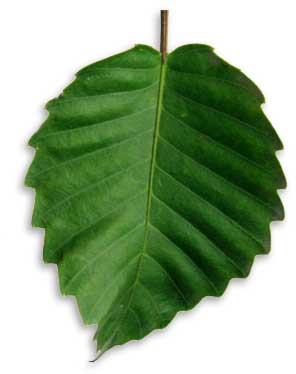 • Antihyperuricemic / Maslinic Acid: Study evaluated the antihyperuricemic potential of compounds isolated from D. philippinensis and the interaction of URAT-1 (urate anion transporter-1) with the bioactive compounds. Molecular docking revealed two compounds with stable interaction and high potency. Profiles considered maslinic acid as the best-hit compound. Scanning depicted glutamine 149 as the most significant amino acid in the protein-ligand interaction. Results established the potential antihyperuricemic property of maslinic acid from katmon via URAT-1 inhibition and may possess promising pharmacology. (23) • Antihyperuricemic / Maslinic Acid: Study evaluated the antihyperuricemic potential of compounds isolated from D. philippinensis and the interaction of URAT-1 (urate anion transporter-1) with the bioactive compounds. Molecular docking revealed two compounds with stable interaction and high potency. Profiles considered maslinic acid as the best-hit compound. Scanning depicted glutamine 149 as the most significant amino acid in the protein-ligand interaction. Results established the potential antihyperuricemic property of maslinic acid from katmon via URAT-1 inhibition and may possess promising pharmacology. (23)
• Potential as Food Preservative: Study evaluated the potential of Katmon fruit extract as natural food preservative. Data revealed a significant correlation between acetic acid concentration in the extract and its antimicrobial effectiveness. The microbial inhibitory effect is attributed to its high antioxidant and acetic acid content. Sensory evaluation suggest the extract does not compromise food quality. Results add to the understanding of natural food preservation and suggest a viable alternative to synthetic additives. (24)
Availability
Wild-crafted. |

![]()

